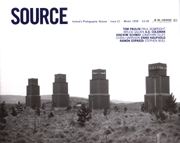War Memorials
by David Brett
Issue 21 Winter 1999
View Contents ▸
View photographs from: Sites of Memory ▸
War memorials are serious objects. Considered artistically they can be of all kinds and every level of quality, but what they all have in common is that they denote and commemorate experiences of terrible import in the lives and deaths of individuals and states. The phrases engraved or carved upon them carry a half-hidden threat... 'In Memoriam', 'Lest we forget'... and what we might forget would be Time itself, and therefore community and identity which are created in and by Time. Thus what monuments represent, and how they represent it, are communal utterances; and how in turn they are represented through other means, such as photography, are a further stage - a kind of commentary upon the process of representation and the passage of time.
Chris Harrison's Sites of Memory: War Memorials at the end of the 20th Century (originally commissioned by the Imperial War Museum) is a collection of images from 6cm x 12cm transparencies. No one type of memorial has been selected; this is an anthology of types and sites, from interior plaques in Waterloo Station and back to the Cenotaph by way of Glencoe and Belfast's suburbs. What they all have in common, however, is a grandiose landscape format and lush colouration. Colour photography when printed almost always lends an excess of colour to its objects, no matter what the size; in this case the result is to give objects we hardly ever examine an ironic splendour. The celtic cross in Glencoe, islanded in light, withstands the rain-forest density of massed rhododendrons; a winged victory on Tyneside becomes part of the stormy sky above her, with her one bare tree. At the same time the monuments are mixed up with some very ordinary street furniture, lamp-posts, pieces of fencing, litter and parked cars and this lays down another layer of meaning - these monuments are also a kind of street furniture themselves that we only notice when we are told to remember.
What we see in this collection is an anthology of styles - Anglican Pre-Raphaelitism, City of London Classicism, Celtic Revivalism to identify but three, each one of which carries with it a distinct ideological baggage. The Highland soldier standing guard over Ballachulish aligns the crofter with an imperial destiny, the railway workers at Waterloo are assumed into the City of Wren and Hawksmoor, and the angel of the suburbs inducts both living and dead into the Celestial City. These are not just sites of Memory, but construction sites for future Identities. They embody a network of myths. These myths are not innocent. The memorial at the corner of Picardy and Bapaume Avenues, Belfast (here flying a Union Jack), has become a territorial marker within an area whose very street names are loaded with political significance. It was not always so; it is only in recent years that the Somme and other atrocities have been mendaciously coopted into an 'Orange' story. Every one of these images tells a similar tale, for the very good reason that memorials, by their very nature as markers of Time, are also markers of changing and contested histories. These photographs show this story-making in action, and - writing in Belfast - they issue a challenge. Just how, at some future date, will it be possible to commemorate the dead of the past thirty years? This is not a small question. To answer it we might want to turn to memorials of other contested, bitter memories - the black granite trench of the Washington Vietnam Memorial, or the desolating blankness of Buchenwald. It is a happy country that can afford to neglect its monuments, even when the neglect, the amnesis, of contemporary life saps at the shared foundations that make social life possible. This is a rich and interesting collection because it directs our attention, with wit and irony, toward a set of biting relevant issues.
Other articles by David Brett:
Other articles mentioning Chris Harrison:
Other articles on photography from the 'Documentary' category ▸






